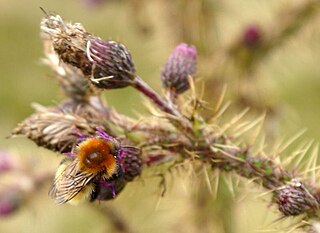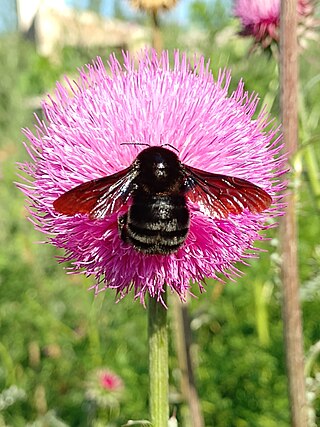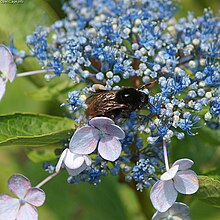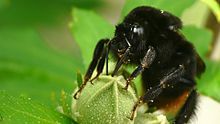
A bumblebee is any of over 250 species in the genus Bombus, part of Apidae, one of the bee families. This genus is the only extant group in the tribe Bombini, though a few extinct related genera are known from fossils. They are found primarily in higher altitudes or latitudes in the Northern Hemisphere, although they are also found in South America, where a few lowland tropical species have been identified. European bumblebees have also been introduced to New Zealand and Tasmania. Female bumblebees can sting repeatedly, but generally ignore humans and other animals.

Bombus terrestris, the buff-tailed bumblebee or large earth bumblebee, is one of the most numerous bumblebee species in Europe. It is one of the main species used in greenhouse pollination, and so can be found in many countries and areas where it is not native, such as Tasmania. Moreover, it is a eusocial insect with an overlap of generations, a division of labour, and cooperative brood care. The queen is monandrous which means she mates with only one male. B. terrestris workers learn flower colours and forage efficiently.

Haplodiploidy is a sex-determination system in which males develop from unfertilized eggs and are haploid, and females develop from fertilized eggs and are diploid. Haplodiploidy is sometimes called arrhenotoky.

Bombus ternarius, commonly known as the orange-belted bumblebee or tricolored bumblebee, is a yellow, orange and black bumblebee. It is a ground-nesting social insect whose colony cycle lasts only one season, common throughout the northeastern United States and much of Canada. The orange-belted bumblebee forages on Rubus, goldenrods, Vaccinium, and milkweeds found throughout the colony's range. Like many other members of the genus, Bombus ternarius exhibits complex social structure with a reproductive queen caste and a multitude of sister workers with labor such as foraging, nursing, and nest maintenance divided among the subordinates.

The early bumblebee or early-nesting bumblebee is a small bumblebee with a wide distribution in most of Europe and parts of Asia. It is very commonly found in the UK and emerges to begin its colony cycle as soon as February which is earlier than most other species, hence its common name. There is even some evidence that the early bumblebee may be able to go through two colony cycles in a year. Like other bumblebees, Bombus pratorum lives in colonies with queen and worker castes. Bombus pratorum queens use aggressive behavior rather than pheromones to maintain dominance over the workers.

The tree bumblebee or new garden bumblebee is a species of bumblebee common in the European continent and parts of Asia. Since the start of the twenty-first century, it has spread to Great Britain. These bumblebees prefer habitats that others do not, allowing them to pollinate flowers in areas that many other species do not get to.

Bombus lapidarius is a species of bumblebee in the subgenus Melanobombus. Commonly known as the red-tailed bumblebee, B. lapidarius can be found throughout much of Central Europe. Known for its distinctive black and red body, this social bee is important in pollination.
Bombus polaris is a common Arctic bumblebee species. B. polaris is one of two bumblebees that live above the Arctic Circle. The other is its social parasite Bombus hyperboreus. B. polaris is a social bee that can survive at near freezing temperatures. It has developed multiple adaptations to live in such cold temperatures. B. polaris has a thicker coat of hair than most bees, utilizes thermoregulation, and makes insulated nests.

Bombus hortorum, the garden bumblebee or small garden bumblebee, is a species of bumblebee found in most of Europe north to 70°N, as well as parts of Asia and New Zealand. It is distinguished from most other bumblebees by its long tongue used for feeding on pollen in deep-flowered plants. Accordingly, this bumblebee mainly visits flowers with deep corollae, such as deadnettles, ground ivy, vetches, clovers, comfrey, foxglove, and thistles. They have a good visual memory, which aids them in navigating the territory close to their habitat and seeking out food sources.

Bombus lucorum, the white-tailed bumblebee, is a species of bumblebee, widespread and common throughout Europe. This name has been widely used for a range of nearly identical-looking or cryptic species of bumblebees. In 1983, Scholl and Obrecht even coined the term Bombus lucorum complex to explain the three taxa that cannot be easily differentiated from one another by their appearances. A recent review of all of these species worldwide has helped to clarify its distribution in Europe and northern Asia, almost to the Pacific. B. lucorum reaches the Barents Sea in the North. However, in southern Europe, although found in Greece it is an upland species with its distribution never quite reaching the Mediterranean.

Bombus pensylvanicus, the American bumblebee, is a threatened species of bumblebee native to North America. It occurs in eastern Canada, throughout much of the Eastern United States, and much of Mexico.

Bombus vosnesenskii, the yellow-faced bumblebee, is a species of bumblebee native to the west coast of North America, where it is distributed from British Columbia to Baja California. It is the most abundant species of bee in this range, and can be found in both urban and agricultural areas. Additionally, B. vosnesenskii is utilized as an important pollinator in commercial agriculture, especially for greenhouse tomatoes. Though the species is not currently experiencing population decline, urbanization has affected its nesting densities, and early emergence of the B. vosnesenskii has been implicated in the increasing lack of bee diversity on the West coast.

Bombus fervidus, the golden northern bumble bee or yellow bumblebee, is a species of bumblebee native to North America. It has a yellow-colored abdomen and thorax. Its range includes the North American continent, excluding much of the southern United States, Alaska, and the northern parts of Canada. It is common in cities and farmland, with populations concentrated in the Northeastern part of the United States. It is similar in color and range to its sibling species, Bombus californicus, though sometimes also confused with the American bumblebee or black and gold bumblebee. It has complex behavioral traits, which includes a coordinated nest defense to ward off predators. B. fervidus is an important pollinator, so recent population decline is a particular concern.

Bombus muscorum, commonly known as the large carder bee or moss carder bee, is a species of bumblebee in the family Apidae. The species is found throughout Eurasia in fragmented populations, but is most commonly found in the British Isles. B. muscorum is a eusocial insect. The queen is monandrous, mating with only one male after leaving a mature nest to found its own. Males mate territorially and the species is susceptible to inbreeding and bottlenecks. The species builds its nests on or just under the ground in open grassland and forages very close to the nest. In recent years, populations have significantly declined due to loss of natural habitat. B. muscorum is currently listed as vulnerable in Europe by the European Red List of Bees.

Bombus affinis, commonly known as the rusty patched bumble bee, is a species of bumblebee endemic to North America. Its historical range in North America has been throughout the east and upper Midwest of the United States, north to Ontario, Canada, where it is considered a "species at risk", east to Quebec, south to Georgia, and west to the Dakotas. Its numbers have declined in 87% of its historical habitat range. On January 10, 2017, the United States Fish and Wildlife Service placed B. affinis on the list of endangered species, making the rusty patched bumblebee the first bee to be added to the list in the continental United States.

Bombus terricola, the yellow-banded bumblebee, is a species of bee in the genus Bombus. It is native to southern Canada and the east and midwest of the United States. It possesses complex behavioral traits, such as the ability to adapt to a queenless nest, choose which flower to visit, and regulate its temperature to fly during cold weather. It was at one time a common species, but has declined in numbers since the late 1990s, likely due to urban development and parasite infection. It is a good pollinator of wild flowers and crops such as alfalfa, potatoes, raspberries, and cranberries.

Bombus pauloensis is a neotropical bumblebee, formerly known as Bombus atratus, that is found throughout regions of South America, including Colombia, Ecuador, Brazil, and Argentina. It lives in social colonies that include a founder queen/queens, workers and brood. B. pauloensis is somewhat unusual because of its potential to oscillate between polygynous and monogynous nesting cycles. Bombus pauloensis was the first species in the genus Bombus that was discovered to display such polygynous nesting patterns. The polygynous nesting cycles lead to certain specific types of behavior including queen-queen aggression. Nests can also be perennial, which is a characteristic rarely found in other bumblebees. B. pauloensis can be helpful to agricultural because of their ability to pollinate different species of plants. B. pauloensis has been found to occupy a range of geographic areas and climates throughout South America. Colonies have the ability to thermoregulate nests and keep them a little bit warmer than the outside environment. Foraging workers use muscle contractions to maintain stable temperatures and coupe with seasonal and daily fluctuations in temperature.

Bombus vancouverensis is a common species of eusocial bumblebee of the subgenus Pyrobombus. B. vancouverensis inhabits mountainous regions of western North America, where it has long been considered as a synonym of Bombus bifarius, and essentially all of the literature on bifarius refers instead to vancouverensis. B. vancouverensis has been identified as one of the two species of bumblebee observed to use pheromones in kin recognition. The other is the frigid bumblebee, Bombus frigidus.
Bombus hypocrita, also known as the short-tongued bumblebee, is a Japanese bumblebee commonly used in commercial pollination. These short-tongued bumblebees have a proboscis about 7-9mm long, which is folded under their head when flying. Bumblebees are a small fuzzy insect with yellow and black banding along their abdomen. They are round and covered in pile, the hair-like structures that give them their distinct fuzzy appearance.
Bombus lantschouensis is one of many bumblebee species native to China. Like all bumblebee species, they are characterized by their round bodies that are larger than honeybees. They have diverse color patterns. but are known for their eye-catching black and yellow coloring. They are also known for their furry-like appearance due to their body being covered in soft hair which are long branched setae. This hair is referred to as pile.



















